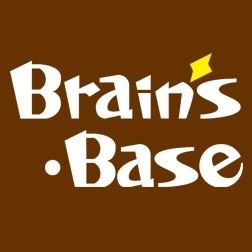"How Heavy Are the Dumbbells You Lift?" is an anime series that will begin airing in the summer of 2019. It is currently being serialized on the comic app "Manga One" and the manga distribution site "Ura Sunday." It's written by Sandrovich Yabako and illustrated by MAAM. As a comedy about high school girls' body transformation, it's a groundbreaking anime that lets you learn serious muscle training techniques while watching high school girls train. In this article, we'll take a closer look at the muscle training menus featured in "How Heavy Are the Dumbbells You Lift?"! Anyone wanting to get in shape is sure to be motivated after reading this work!
Before we introduce the muscle training menus, what kind of work is "How Heavy Are the Dumbbells You Lift?"?
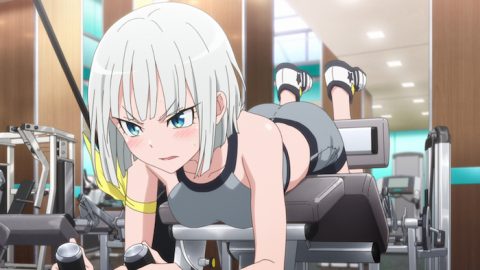
First, let me introduce the story of "How Heavy Are the Dumbbells You Lift?". Hibiki Sakura, a high school girl who absolutely loves to eat, is a second-year student at Kouou Girls' Academy. One day, a friend asks her, "Have you gained weight recently?" Shocked, Hibiki decides to go on a diet. So, she decides to join the newly opened "Silverman Gym" in her neighborhood. While checking it out, she meets Akemi Soryuin, an honor student at the same school. This is an anime about high school girls' struggles at their own sports gym.
It's actually pretty serious!
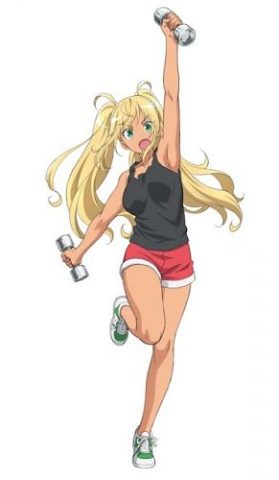
If you've ever decided you want to get in shape or lose weight, but then picked up a specialized book, it's difficult to read, you lose motivation, and you end up giving up. "How Heavy Are the Dumbbells You Lift?" is a work I highly recommend to people like you! It clearly explains the muscle training methods with illustrations, and because it's a manga, you'll find that the muscle training methods will easily sink in as you follow the story. It's easy to pick up and perfect for boosting motivation.
Muscle Training Menu Introduction Part 1: Squats
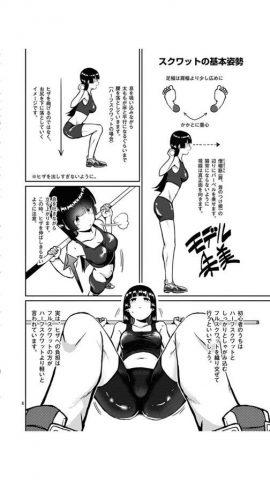
First, let's start with the most basic of basics: squats. For basic posture, place your feet slightly wider than shoulder-width apart. The key is to keep your center of gravity in your heels. Next, place the barbell around your trapezius muscles, located at the base of your shoulders and neck, and look straight ahead. The key is to avoid slouching.
When Lowering Your Hips
When performing a half squat, inhale and lower your hips until your thighs are parallel to the floor. Imagine lowering your hips, rather than bending your knees. It's important not to extend your knees too far. When standing up, exhale and be careful not to overextend your knees. Another important point is not to hold your breath. Many people hold their breath when they're not used to the exercise, but this halves the effectiveness of the training. Focus on your breathing.
Muscle Training Menu Introduction Part 2☆Bodyweight Squats
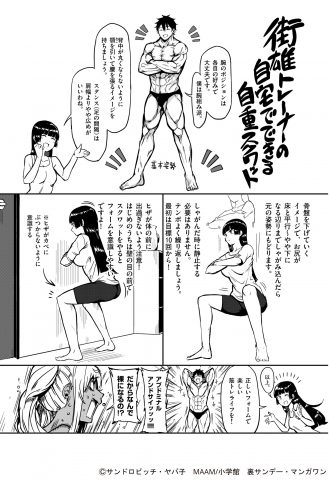
Next, I'll introduce the even easier "bodyweight squat." This doesn't require a barbell, so you can do it at home anytime. First, position your arms wherever you like. Incidentally, Machio prefers crossing his arms, so if you're unsure, you can still do that. The basic posture is to place your feet slightly wider than shoulder width apart and avoid slouching. It's also helpful to tuck your chin and imagine your lower back is straight. From that position, lower your hips, imagining that you're lowering your pelvis. Lower your legs until they are parallel to the floor or slightly below it, then return to the starting position. There's no need to stop after squatting; simply repeat this movement at a steady pace. This is surprisingly hard, so it's a good idea to aim for 10 repetitions.
Understanding
Be careful, your knees will tend to extend forward! Until you get used to it, squatting in front of a wall can help you focus on your body shape. Also, make sure your knees don't hit the wall.
Muscle Training Menu #3 ☆ Plank
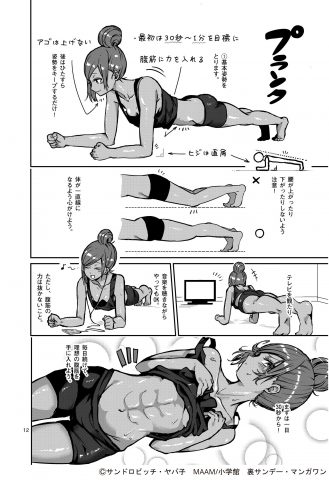
Now, let's take a closer look at the muscle training menu, "Plank." First, assume the basic position shown in the image. Bend your elbows at a right angle and support your body on your toes. Engage your abdominal muscles and be careful not to lift your chin. It's important to be careful not to let your hips rise or fall. It's difficult at first because your body will shake, but you need to try to keep your body in a straight line. Simply staying in the basic position for a while is a muscle workout, but it's quite hard. Start with 30 seconds to 1 minute, and gradually increase the time.
Stretching while doing other things!
The best thing about this exercise is that it's easy to do while doing other things. All you need to do is maintain this position, so you can do it while watching TV or listening to music, for example. However, be careful not to relax your abdominal muscles, as this will negate the effect. Starting with 30 seconds of this exercise a day will help you achieve your ideal abs.
Muscle Training Menu #4☆Bench Press
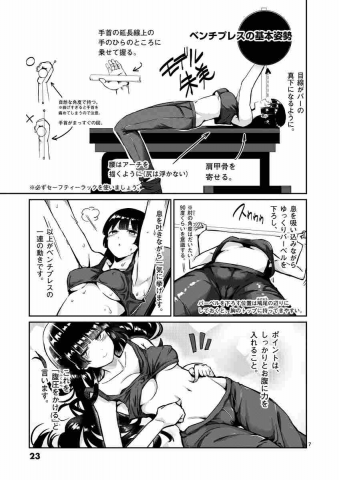
Now, let's explain how to do the bench press. First, assume the basic position shown in the image. Keep your gaze fixed directly below the bar and squeeze your shoulder blades together. Keep your hips in the air and imagine your lower back is arched. Hold the barbell with your palms in line with your wrists. Hold it at a natural angle to avoid straining your wrists.
Lowering the Barbell
When lowering the barbell, inhale and do so slowly! It's a good idea to keep your elbows at about a 90-degree angle. It's also important to lower the barbell around your solar plexus, as this will make it easier to bring it to the top of your chest. Then, exhale and lift it up in one go.
What parts of the body does this train?
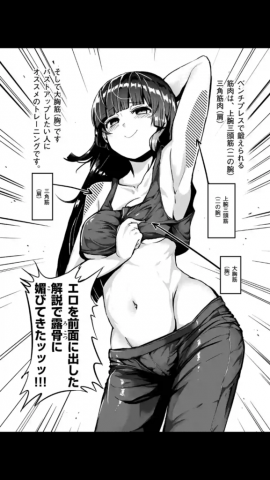
The bench press also works the triceps in the upper arms, the deltoids in the shoulders, and the pectoralis major in the chest. This makes it a highly recommended workout for anyone looking to increase their bust size. The key to bench press is to fully engage your abdominal muscles! Also, because holding a barbell can be dangerous, be sure to use a safety rack!
Muscle Training Menu Introduction Part 4☆Side Bends
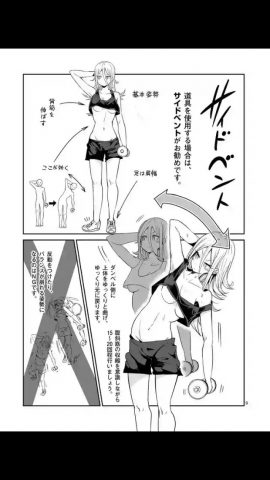
Next, we'll introduce "side bends," a workout for strengthening the flanks. This is a highly recommended exercise for anyone concerned about their abdominal area. This is a great workout to perform using equipment, but the basic posture is as shown in the image. Stand tall, stand with your feet shoulder-width apart, and hold a dumbbell in one hand. Slowly bend your torso toward the dumbbell, then slowly return to the starting position. Repeat this movement. It's easy to understand by focusing on contracting your obliques as you do this. Repeat this 15 to 20 times. Be careful not to lose your balance! Also, since using momentum to bounce back would be pointless, maintain basic posture and only move your upper body.
Works for your body without tiring you out!
If you have dumbbells or other equipment at home, this is a must-try! It's not a very strenuous workout, so it won't tire you out, but it does burn a lot of energy! This can lead to muscle soreness, so give it a try and see for yourself.
Muscle Training Menu Introduction #5☆Dynamic Stretching

This brings us to a shocking truth: stretching before exercise is completely useless! In fact, it's even harmful. We tend to think of stretching before exercise to prevent injury. However, it can be dangerous. Forcing yourself to stretch when your upper body isn't warmed up at all can strain your tendons and joints. There's even data that suggests stretching can even decrease performance! However, many people are unaware of this fact, and most gymgoers stretch before training. So, is it better to do nothing before exercise?
No! Try "Dynamic Stretching"
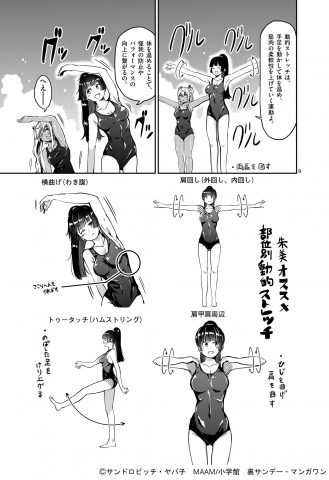
So, does that mean it's better not to move your body at all? Not at all. At this point, you should perform "dynamic stretching." "Dynamic stretching" refers to exercises that warm up your body by moving your arms and legs and increase muscle flexibility. Warming up your body can help prevent injury and even improve performance. In any case, being cold is bad for your body. Rotate both shoulders in circles, then rotate them outward and inward. To stretch the area around your shoulder blades, imagine bending your elbows and rotating your shoulders. When stretching your sides, stretch your arms comfortably, imagining that you're stretching your lateral hamstrings just below your chest. For toe touch (hamstrings), stretch by imagining that you're kicking your extended leg up.
This is the perfect pre-exercise stretch!
That's it for "dynamic stretching." It was quite a surprise to learn that pre-exercise training can be harmful. By doing this "dynamic stretching" before starting your workout, you'll dramatically improve the efficiency of the workouts we've introduced so far. I also highly recommend this for anyone who plays sports to improve their performance!
Protein: A Recommended Nutrient for Muscle Training

Protein is the most important nutrient for building muscle. Gina lists beef as a food rich in protein. Gina's research into Hibiki's strength led her to discover her frequent consumption of beef. Hibiki loves to eat out, and she works part-time at a beef shop five days a week to support herself. This is likely where Gina made the connection. In any case, if you want to build muscle, you should of course do some strength training, but making sure to also take in some protein will likely increase your results.
Recommended Supplements for Those Wanting to Increase Muscle Strength

Finally, I'd like to introduce some recommended supplements. These are supplements that increase muscle strength, and my recommendation here is creatine. For anyone who is serious about muscle training, I highly recommend this supplement. I highly recommend taking it together with protein. One of the effects of creatine is that it improves athletic performance. It allows you to train more intensely, which can lead to increased muscle strength. Another great thing about it is that it helps you recover from fatigue faster after a workout! Creatine comes in powder form, but it's not very soluble in water. For this reason, we recommend mixing it with protein before taking it.
Recommended Muscle Training Menus!
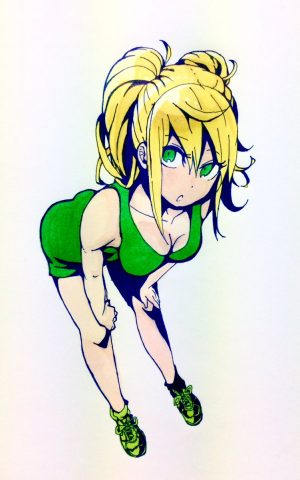
That concludes our introduction to the recommended muscle training menus featured in "How Heavy Are the Dumbbells You Lift?"! Unlike typical muscle training books, the characters provide easy-to-understand explanations, making it easy to understand. And because it's read like a manga story, the muscle training menus are easy to remember. It's also great for boosting motivation. If watching this show has piqued your interest in muscle training, why not give it a try, starting with an easy one?




